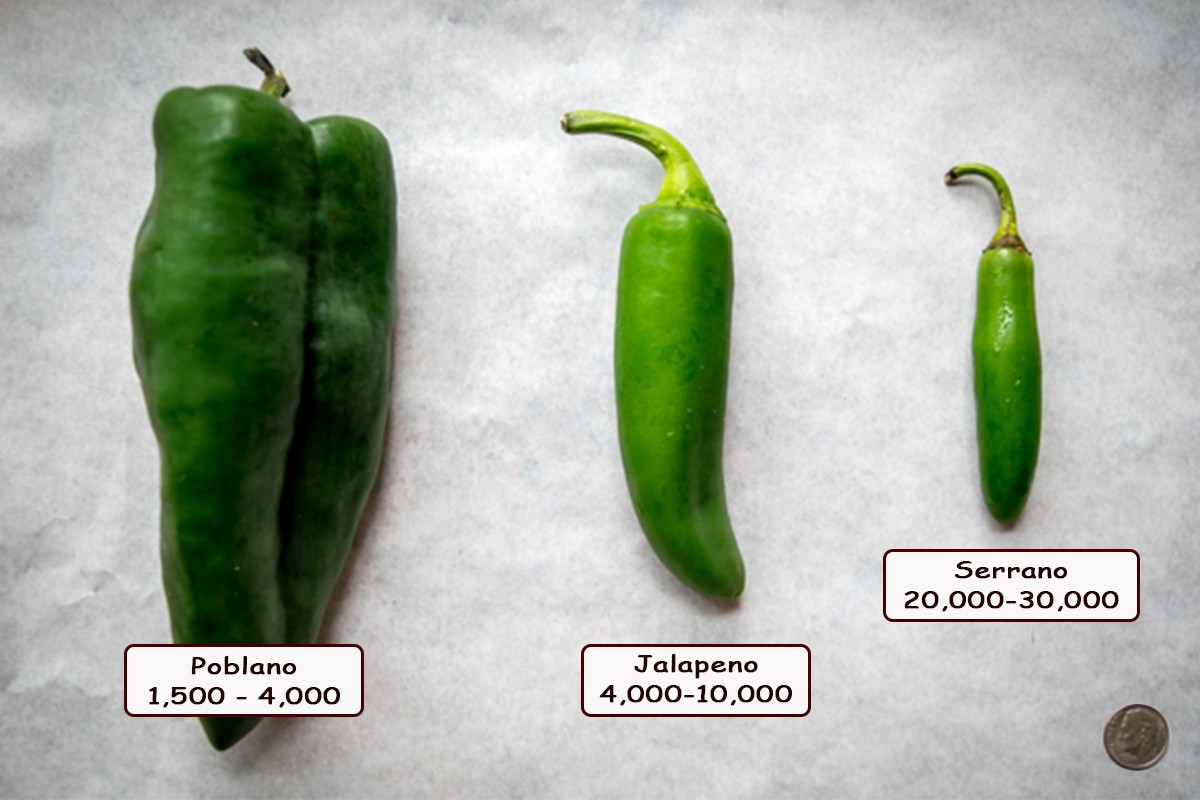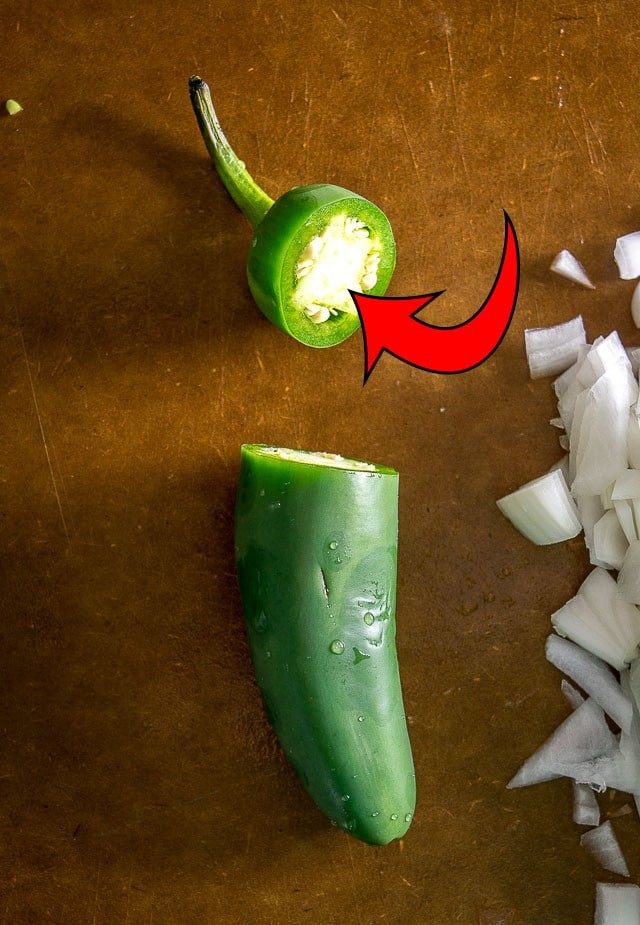Serrano peppers vs jalapenos: Exploring heat levels and culinary applications on COMPARE.EDU.VN. If you’re navigating the world of chili peppers, understanding the nuances between serrano and jalapeno peppers is crucial for culinary success; COMPARE.EDU.VN provides a comprehensive comparison of these two popular peppers. This guide dives deep into their heat levels, flavor profiles, and ideal uses, equipping you with the knowledge to make informed decisions in your kitchen, focusing on pepper comparisons, spicy food insights, and recipe adjustments.
1. Understanding Serrano and Jalapeno Peppers
To effectively compare serrano and jalapeno peppers, it’s essential to understand each pepper’s individual characteristics. Let’s delve into their origins, physical attributes, and flavor profiles.
1.1. Origins and History
- Jalapeno: Originating from Mexico, jalapenos have been cultivated for centuries and are named after the city of Xalapa, Veracruz. They are a staple in Mexican cuisine and have gained popularity worldwide.
- Serrano: Also native to Mexico, serrano peppers are believed to have originated in the mountainous regions of Puebla and Hidalgo. The name “serrano” refers to the term “sierra,” meaning mountains or highlands.
1.2. Physical Characteristics
| Feature | Jalapeno | Serrano |
|---|---|---|
| Size | 2-3.5 inches long, 1 inch wide | 1-2 inches long, 0.5 inch wide |
| Shape | Cylindrical, slightly curved | Straight, slender |
| Color | Typically green, maturing to red | Typically green, maturing to red |
| Skin | Smooth, glossy | Smooth, glossy |
| Flesh | Thick, juicy | Thinner, slightly drier |


1.3. Flavor Profiles
- Jalapeno: Jalapenos offer a balanced flavor with a mild, grassy taste and a subtle sweetness. The heat is noticeable but generally manageable for most palates.
- Serrano: Serranos have a brighter, crisper flavor compared to jalapenos. They possess a more intense heat and a slightly grassy or vegetal taste.
2. Scoville Heat Units (SHU): Measuring the Heat
The Scoville scale, developed by pharmacist Wilbur Scoville in 1912, measures the pungency (spiciness or “heat”) of chili peppers. The scale is based on the concentration of capsaicinoids, the chemical compounds responsible for the spicy sensation.
2.1. Jalapeno Scoville Units
Jalapenos typically range from 2,500 to 8,000 Scoville Heat Units (SHU). This makes them a relatively mild to medium-heat pepper, suitable for a wide range of culinary applications.
2.2. Serrano Scoville Units
Serrano peppers generally range from 10,000 to 23,000 SHU. This significantly higher range indicates that serranos are considerably hotter than jalapenos.
2.3. Scoville Scale Comparison Table
| Pepper | Scoville Heat Units (SHU) |
|---|---|
| Bell Pepper | 0 |
| Poblano | 1,000 – 1,500 |
| Jalapeno | 2,500 – 8,000 |
| Serrano | 10,000 – 23,000 |
| Cayenne | 30,000 – 50,000 |
| Habanero | 100,000 – 350,000 |
| Scotch Bonnet | 100,000 – 350,000 |
| Ghost Pepper | 800,000 – 1,041,427 |
| Carolina Reaper | 1,400,000 – 2,200,000 |
2.4. Factors Affecting Heat Levels
It’s important to note that the exact heat level of a chili pepper can vary depending on several factors:
- Growing Conditions: Climate, soil type, and sunlight exposure can influence the capsaicin content of peppers.
- Maturity: Peppers tend to become hotter as they mature. Green jalapenos are generally milder than red jalapenos.
- Plant Variety: Different varieties of jalapenos and serranos may have slightly different heat levels.
3. Culinary Uses of Serrano and Jalapeno Peppers
Both serrano and jalapeno peppers are versatile ingredients used in a variety of cuisines. However, their distinct heat levels and flavor profiles make them suitable for different applications.
3.1. Jalapeno in Cooking
Jalapenos are widely used in Mexican, Tex-Mex, and Southwestern cuisines. They are often:
- Pickled: Jalapenos are commonly pickled and used as a condiment or topping for nachos, tacos, and sandwiches.
- Stuffed: Jalapenos poppers, stuffed with cheese and deep-fried, are a popular appetizer.
- In Sauces: Jalapenos add a mild heat and flavor to salsas, sauces, and marinades.
- Grilled or Roasted: Grilling or roasting jalapenos can mellow their heat and enhance their smoky flavor.
- Fresh: Diced jalapenos can be added to salads, guacamole, and other dishes for a fresh, spicy kick.
3.2. Serrano in Cooking
Serrano peppers are favored in dishes where a higher level of heat is desired. They are commonly used in:
- Salsas: Serranos add a significant kick to salsas, often used in smaller quantities than jalapenos.
- Hot Sauces: Serranos are a popular ingredient in homemade hot sauces.
- Pickled: Pickled serranos can be used as a spicy condiment.
- Asian Cuisine: Serranos are used in some Southeast Asian dishes to add heat and flavor.
- Stews and Soups: Thinly sliced serranos can be added to stews and soups for a spicy depth.
3.3. Recipe Adjustments
When substituting serrano peppers for jalapenos (or vice versa), it’s crucial to adjust the quantity to achieve the desired heat level.
- Serrano for Jalapeno: If a recipe calls for one jalapeno, start with half a serrano and taste as you go. You can always add more, but you can’t take the heat away.
- Jalapeno for Serrano: If a recipe calls for one serrano, use two or three jalapenos, depending on your heat preference.
3.4. Heat Management Techniques
- Removing Seeds and Membranes: The seeds and inner membranes (pith) of chili peppers contain the highest concentration of capsaicin. Removing them can significantly reduce the heat.
- Pairing with Dairy: Dairy products like milk, yogurt, and cheese contain casein, a protein that helps break down capsaicin and reduce the burning sensation.
- Adding Acid: Acidic ingredients like lime juice, vinegar, and tomatoes can help neutralize the heat.
- Balancing with Sweetness: A touch of sweetness from sugar, honey, or fruit can help balance the spiciness.
4. Taste Test: Serrano vs. Jalapeno
Conducting a side-by-side taste test can help you appreciate the subtle differences in flavor and heat between serrano and jalapeno peppers.
4.1. Preparing the Peppers
- Wear gloves to protect your hands from capsaicin.
- Wash the peppers thoroughly.
- Cut a small piece from each pepper and remove the seeds and membranes from one piece of each pepper.
4.2. Tasting the Peppers
- Taste the seeded and unseeded pieces separately.
- Note the initial heat, the overall flavor, and the lingering sensation.
- Cleanse your palate between tastings with a piece of bread or a sip of milk.
4.3. Observations
Most people will find that the serrano pepper has a more intense heat and a slightly crisper flavor compared to the jalapeno. Removing the seeds and membranes will reduce the heat in both peppers, but the serrano will still likely be hotter.
5. Health Benefits of Chili Peppers
Chili peppers, including serranos and jalapenos, offer several health benefits due to their capsaicin content and other nutrients.
5.1. Capsaicin Benefits
- Pain Relief: Capsaicin has analgesic properties and can help relieve pain associated with arthritis, neuropathy, and headaches.
- Metabolism Boost: Capsaicin can increase metabolism and promote weight loss by increasing thermogenesis (heat production) in the body.
- Cardiovascular Health: Capsaicin can help lower blood pressure and improve circulation.
- Anti-Inflammatory: Capsaicin has anti-inflammatory properties and can help reduce inflammation in the body.
5.2. Nutritional Value
Chili peppers are a good source of:
- Vitamin C: An antioxidant that supports immune function.
- Vitamin A: Important for vision and skin health.
- Vitamin K: Essential for blood clotting and bone health.
- Fiber: Promotes digestive health.
5.3. Precautions
- Skin Irritation: Capsaicin can cause skin irritation and burning. Always wear gloves when handling chili peppers.
- Eye Irritation: Avoid touching your eyes after handling chili peppers.
- Digestive Issues: Consuming large amounts of chili peppers can cause digestive upset in some individuals.
- Medication Interactions: Capsaicin may interact with certain medications, such as blood thinners. Consult with your doctor if you have any concerns.
6. Growing Serrano and Jalapeno Peppers
Growing your own serrano and jalapeno peppers can be a rewarding experience. Here are some tips for successful cultivation:
6.1. Starting Seeds
- Start seeds indoors 6-8 weeks before the last expected frost.
- Use a seed-starting mix and keep the soil moist and warm.
- Transplant seedlings outdoors after the last frost when the soil has warmed up.
6.2. Planting and Care
- Choose a sunny location with well-drained soil.
- Space plants 18-24 inches apart.
- Water regularly, especially during dry periods.
- Fertilize with a balanced fertilizer every few weeks.
- Provide support for plants as they grow to prevent them from falling over.
6.3. Pest and Disease Control
- Monitor plants for pests like aphids, spider mites, and whiteflies.
- Use insecticidal soap or neem oil to control pests.
- Prevent fungal diseases by providing good air circulation and avoiding overwatering.
6.4. Harvesting
- Harvest peppers when they reach their desired size and color.
- Use pruning shears or scissors to cut peppers from the plant.
- Handle peppers carefully to avoid bruising.
7. Storing Serrano and Jalapeno Peppers
Proper storage can extend the shelf life of your serrano and jalapeno peppers.
7.1. Refrigeration
- Store fresh peppers in a plastic bag in the refrigerator for up to two weeks.
- Avoid washing peppers before storing, as moisture can promote spoilage.
7.2. Freezing
- Wash and dry peppers thoroughly.
- Freeze peppers whole or sliced in a single layer on a baking sheet.
- Transfer frozen peppers to a freezer bag or container for long-term storage.
7.3. Pickling
- Pickling is a great way to preserve peppers for several months.
- Follow a reliable pickling recipe and use proper canning techniques to ensure food safety.
7.4. Drying
- Drying peppers is another effective preservation method.
- Use a dehydrator or hang peppers in a well-ventilated area until they are completely dry.
- Store dried peppers in an airtight container in a cool, dark place.
8. Serrano vs. Jalapeno: Which Pepper is Right for You?
Choosing between serrano and jalapeno peppers depends on your heat preference and the specific dish you are preparing.
8.1. Consider Your Heat Tolerance
If you prefer a mild to medium heat, jalapenos are a great choice. If you enjoy a more intense heat, serranos are a better option.
8.2. Think About the Flavor Profile
Jalapenos offer a balanced flavor with a mild, grassy taste and a subtle sweetness. Serranos have a brighter, crisper flavor and a slightly grassy or vegetal taste.
8.3. Experiment and Adjust
Don’t be afraid to experiment with both peppers and adjust the quantity to achieve your desired heat level and flavor.
8.4. Use Cases
- Jalapenos: Ideal for salsas, nachos, poppers, and dishes where a mild to medium heat is desired.
- Serranos: Best for hot sauces, spicy salsas, stews, and dishes where a significant kick is needed.
9. Exploring Other Chili Pepper Varieties
Once you’re familiar with serrano and jalapeno peppers, you can explore other chili pepper varieties to expand your culinary horizons.
9.1. Poblano
Poblano peppers are mild chili peppers with a rich, earthy flavor. They are often used in Mexican cuisine, particularly in dishes like chiles rellenos.
9.2. Anaheim
Anaheim peppers are mild chili peppers with a slightly sweet flavor. They are commonly used in Southwestern cuisine and are often roasted or stuffed.
9.3. Cayenne
Cayenne peppers are medium-hot chili peppers with a fruity flavor. They are often used in spice blends, hot sauces, and chili powders.
9.4. Habanero
Habanero peppers are very hot chili peppers with a citrusy flavor. They are often used in Caribbean and Mexican cuisine and should be used sparingly due to their intense heat.
9.5. Scotch Bonnet
Scotch bonnet peppers are similar in heat and flavor to habaneros. They are commonly used in Caribbean cuisine, particularly in jerk seasoning.
10. Conclusion: Mastering the Art of Chili Pepper Comparison
Understanding the differences between serrano and jalapeno peppers, as well as other chili pepper varieties, is essential for any home cook or culinary enthusiast. By considering their heat levels, flavor profiles, and culinary applications, you can confidently choose the right pepper for your dishes and create delicious, flavorful meals. Remember, COMPARE.EDU.VN is your trusted resource for comprehensive comparisons, empowering you to make informed decisions in all aspects of your life, from food to education.
10.1. Key Takeaways
- Serrano peppers are significantly hotter than jalapenos, ranging from 10,000 to 23,000 SHU compared to 2,500 to 8,000 SHU for jalapenos.
- Serranos have a brighter, crisper flavor, while jalapenos offer a balanced flavor with a mild, grassy taste.
- Adjust the quantity when substituting serrano peppers for jalapenos (or vice versa) to achieve the desired heat level.
- Consider your heat tolerance and the specific dish you are preparing when choosing between serrano and jalapeno peppers.
- Explore other chili pepper varieties to expand your culinary horizons.
10.2. Explore More at COMPARE.EDU.VN
Ready to dive deeper into the world of comparisons? Visit COMPARE.EDU.VN to explore a wide range of topics, from culinary ingredients to educational resources. Make informed decisions and discover new possibilities with our comprehensive comparison guides.
10.3. Contact Us
Have questions or suggestions? We’d love to hear from you! Contact us at:
Address: 333 Comparison Plaza, Choice City, CA 90210, United States
WhatsApp: +1 (626) 555-9090
Website: COMPARE.EDU.VN
FAQ: Serrano vs. Jalapeno
1. Are serrano peppers always hotter than jalapenos?
Yes, serrano peppers are generally hotter than jalapenos. However, the exact heat level can vary depending on growing conditions and maturity.
2. Can I substitute serrano peppers for jalapenos in a recipe?
Yes, you can substitute serrano peppers for jalapenos, but you should use a smaller quantity of serranos due to their higher heat level.
3. What is the best way to reduce the heat of a chili pepper?
Removing the seeds and inner membranes (pith) of the pepper can significantly reduce the heat. Pairing with dairy or acidic ingredients can also help neutralize the heat.
4. How should I store fresh chili peppers?
Store fresh chili peppers in a plastic bag in the refrigerator for up to two weeks. Avoid washing peppers before storing, as moisture can promote spoilage.
5. What are the health benefits of chili peppers?
Chili peppers offer several health benefits due to their capsaicin content and other nutrients, including pain relief, metabolism boost, and cardiovascular health.
6. Can chili peppers cause skin irritation?
Yes, capsaicin can cause skin irritation and burning. Always wear gloves when handling chili peppers.
7. What is the Scoville scale?
The Scoville scale measures the pungency (spiciness or “heat”) of chili peppers based on the concentration of capsaicinoids.
8. Are there any precautions I should take when consuming chili peppers?
Consuming large amounts of chili peppers can cause digestive upset in some individuals. Capsaicin may also interact with certain medications. Consult with your doctor if you have any concerns.
9. How can I grow my own chili peppers?
Start seeds indoors 6-8 weeks before the last expected frost. Choose a sunny location with well-drained soil and provide regular watering and fertilization.
10. What are some other chili pepper varieties I can explore?
Some other chili pepper varieties to explore include poblano, Anaheim, cayenne, habanero, and scotch bonnet peppers.
11. Testimonials: Real Experiences with Serrano and Jalapeno
11.1. User 1: Maria G.
“I love using jalapenos in my homemade salsa, but sometimes I want a little more kick. I’ve found that adding just a small amount of serrano pepper takes my salsa to the next level. Thanks to COMPARE.EDU.VN for helping me understand the heat differences.”
11.2. User 2: David L.
“I always thought jalapenos were too mild for me, but I was hesitant to try serranos because I was afraid they would be too hot. After reading this article, I decided to give serranos a try, and I’m so glad I did! They add the perfect amount of heat to my chili.”
11.3. User 3: Sarah K.
“I’m a beginner cook, and I was always confused about which chili pepper to use in my recipes. This guide has been incredibly helpful in understanding the differences between serrano and jalapeno peppers. I now feel much more confident in my ability to choose the right pepper for my dishes.”
12. Call to Action
Ready to make informed decisions about your culinary choices? Visit compare.edu.vn today to explore more comparisons and discover new possibilities!
